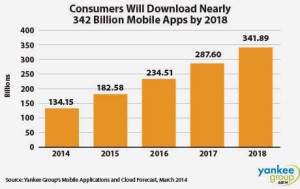Why App Developers Will Use TV Advertisements in Their Marketing Strategy?
But why are Indian app developers going the traditional way all of a sudden to advertise their products?

It is not just in India.
The trend seems to be in practice in other parts of the world too for quite some time. Japan is already known to mass advertise mobile games on national channels during peak hours. And rightly have they been successful in their marketing strategy. Big game tycoons like DeNA, GREE, GungHo, Colopl are some of the names known to promote their games regularly on the Japanese TV stations. 3 months prior to 28 November, 2013, the number of users registered to Colopl’s game “Quiz RPG: World of Mystic Wiz” was 3 million. The real surprise came after 3 months, when they started to run TV commercials and witnessed a whooping rise of 14 million users.
Running television commercials for apps are no more popular only in the East, as the trend gradually transcends across boundaries to become a marketing technique in the West too. Mobile game brands like ‘Clash of Clans’, ‘Game of Wars’ have implemented this strategy to advertise their apps, featuring stars like Liam Neeson and Kate Upton and found them to be among the top grossing gaming app list.
2015 is the dawn of a new rise in the digital marketing scenario, as TV and online media became partners to give a holistic approach to both consumers and advertisers alike. But commercial advertisements do come with high budget cost, compared to the expenditure that one has to invest, had they just resorted to ordinary internet marketing like email marketing, SEO, content marketing, etc.
So what makes the trend to change, as mobile companies embrace the new silver screen on television?
#1 – High Cost Expenditure Is Just an Old Myth
Yes! Many advertisement and television production houses, offer packages that not only help to advertise a particular app but also provide them proper assistance in media planning and buying network spots in popular channels like SkyTV, MTV and other names. A similar approach was taken last month by a Berlin based station, Quaid Media that launched the Burst TV service. The branding campaigns would however be aired for a maximum period of two to three days though. But developers can avail the Burst Premium package to run their commercials on holidays and weekends. A Burst TV package could cost you almost half of the six digit figure that generally comes with the traditional advertisements.
#2 – A 30 Seconds Commercial, Talks More Than the Limited Ad Space
Traditional mobile ads may come with clear CTA (Call to Actions), like ‘Play Now’ or ‘Free Download’ but the shortage of space, limits the copy length for detailed explanation or demonstration as such. On the other hand, a thirty second commercial advertisement can take a customer through a visually appealing journey to demonstrate every feature of the app in detail, explaining as to why they need to monetize in it.
#3 – A Better Brand Awareness Building Strategy
According to Ball State University, in an American household, an average man spends more than four and a half hours per day in front of the television. So, there is always a possibility that your advertisement is going to be viewed by approximately hundreds of people, if aired at the right time. It is uncertain as to whether every one of those who come across you advertisement is likely to convert. Nevertheless, the general brand building awareness would be greater, when compared to the ad space displayed online. According to Thomas Sommer, Senior content manager of Berlin based AppLift, other than the up-front expenditure that one has to incur for running a commercial advertisement, potential end results are also an important factor to consider.
#4 – Availability of More Sophisticated Technology
Access to more sophisticated technology like set top boxes and connected TVs, will provide advertisers with better access to consumer information and insights. With sophisticated technology, comes great benefits as consumer data will help advertisers keep track of the specific ad contents that can be aired at a specific time when the user is watching the television. Programmatic TV advertisements will continue to expand with the new arrival of technology platforms like AudienceXpress and Clypd into the market.
#5 – TV Is Going To Be Watched More When On the Move
Nowadays, a person is not restricted to watching just the TV when he/she wants to catch a movie serial or a daily soap. The daily busy schedule and the changing lifestyle of a person has influenced his/her consumer habit, as the viewer now prefers to watch the TV online whenever he/she is on the move or when he/she has missed a particular show. Today, almost half of the total number of viewers can now find a second screen when watch a TV. And, this trend of multitasking is expected to rise this year, in 2015. While TV networks have tried to embrace this second screen by developing apps that will elevate a viewer’s TV watching experience to a different level, app developers too can follow the reverse strategy to acquire new prospects for their primary medium, the mobile phone. Renowned gaming app developing companies like the Supercell, Big Fish and King have already embraced this second screen.
This changing consumer behavior will move advertisers to merge online budget, TV budget, mobile budget and video budget and come forward with an integrated campaign strategy.
#6 – Brands Will Begin To Combine both TV and Online Data to Measure Their ROI
The Gross Rating Point, which was used initially to measure a traditional television ad campaign will now be implemented for campaigns online to bring a linear attribution of both point. Already a large number of companies like Active GRP and Nielsen OCR have started to go ahead with this move. So, the ultimate question is , how do you measure the gross ROI you are receiving from a TV commercial per month? Unlike the traditional online banner ads that come with a link to track down the number of visits per click, TV advertisements do not have such measurement tools. Ofcourse, you cannot ask a viewer to type down one long URL to access the app online. That would be asking him/her to do the extra work.
There are two ways to approach this situation when measuring the ROI you receive from a TV ad – the Performance oriented approach and the Delta approach. According to the first method, you can run an advertisement and end it with a clear Call-To-Action message such as ‘Visit the App Store To Download Now!’. This approach is similar to the organic approach, where a prospect will organically search for an app online and then download it.

The other method is the Delta approach. This method includes the Performance oriented approach. Just calculate the number of downloads you used to receive before you ran a commercial advertisement for your app. Then measure the total number of downloads your app received after running an ad. Subtract to find the average number and you have calculated your monthly ROI.
There is also the SMS approach, where you conclude an advertisement with a CTA message that says, “send a text message to XXXXXXX to receive the download link’. However, this is a rarely used step.
Some Recent Indian Brand App Names to Use TV for Their Brand Promotion
-
Gaana.com App
Referred to as the ‘first multimedia campaign’ of its kind, Gaana.com started its campaign with the slogan “Bas Bajna Chahiye” . With the aim to give the app a push, the musical campaign brings a content marketing strategy that helps to promote the app as a brand. What the musical campaign emphasizes here is that, no matter whichever situation you fall into, all you need is music to make it awesome as goes the line –
Jo bhi situation to make it awesome,
Bas Bajna Chahiye Gaana.
The musical campaign have received tremendous response and has further encouraged the brand to use it as a ‘full-fledged’ campaign across various media vehicles.
-
Hotstar App
Launched by Novi Digital Entertainment Pvt. Ltd, the app is one of Star India’s biggest and the latest initiative to change the content consumption behavior of the Indians. The app is said to offer content, available in 7 different languages that span over a time period of more than 35,000 hours. The app is available across operating platforms like iOS and Android and has a vast library for television shows, movies and live sports. Sanjay Gupta, Chief Operating Officer, speaks of the idea to make it a ‘one stop’ destination, where users can conveniently access premium content across several languages and genres at their own need.
Just a week after its launch, the app is reported to have received over 1.5 million downloads thus acquiring the top position in the free app list on Android Play Store.
-
Hike
It has been more than a year now that the popular Indian based messaging app, Hike ran commercial advertisement s on media platforms like the tv, radio and movie theatres. It is through these ads that the messenger highlights some of its major features like the ‘hidden mode’, ‘theme stickers’ and unlimited free SMS service. This had led to the growth of the number of Hike users, under the age group of 25 years by ninety percent. According to Sunil Bharti Mittal, the Founder chairman of Bharti Airtel,
Since its launch, the TVC has led to Hike adding new users at the rate of 150,000-200,000 per day,…”.
TV commercial advertisements are said to be multifaceted tools that can be used not only to address user acquisition but also help to build successful brand awareness among users. So, though it may turn out to highly expensive to invest on, nevertheless, commercial ads aired on TV, will bring you long term better ROI than mobile advertisements.
Article Written By: Riya Ghosh. You can follow her on Twitter
- Meet Top 5 Indian Bloggers to Find Inspiration for Your Own Blogging Journey - July 30, 2019
- Why Use DRM Media Converter and Spotify Music Converter Only - May 24, 2019
- SendPulse – For Email Marketing Services with Atomic Results - November 8, 2017





